Your network contains a single-domain Active Directory Domain Services (AD DS) forest named conto.com. The forest contains the servers shown in the following exhibit table.

You plan to install a line-of-business (LOB) application on Server1. The application will install a custom windows services.
A new corporate security policy states that all custom Windows services must run under the context of a group managed service account (gMSA). You deploy a root key.
You need to create, configure, and install the gMSA that will be used by the new application.
Which two actions should you perform? Each correct answer presents part of the solution.
NOTE: Each correct selection is worth one point.
Your network contains an Active Directory Domain Services (AD DS) domain named contoso.com. The domain contains a DNS server named Server1. Server1 hosts a DNS zone named fabrikam.com that was signed by DNSSEC.
You need to ensure that all the member servers in the domain perform DNSSEC validation for the fabrikam.com namespace.
What should you do?
You have an on-premises server named Server1 that runs Windows Server. You have an Azure virtual network that contains an Azure virtual network gateway. You need to connect only Server1 to the Azure virtual network. What should you use?
You need to sync files from an on-premises server named Server1 to Azure by using Azure File Sync
You have a cloud tiering policy that is configured for 30 percent free space and 70 days.
Volume f on Server1 is 500 GB.
A year ago. you configured E:\Oata on Server1 to sync by using Azure File Sync. The files that are visible in E:\Data are shown in the following table.

Volume E does NOT contain any other files.
Where are File1 and flle3 located? To answer, select the appropriate options In the answer area.

You have an Active Directory Domain Services (AD DS) domain that contains a group named Group1.
You need to create a group managed service account (gMSA) named Account1. The solution must ensure that Group1 can use Account1.
How should you complete the script? To answer, select the appropriate options in the answer area,
NOTE: Each correct selection is worth one point.

You have an Azure virtual machine named VM1 that contains the drives shown in the following table.
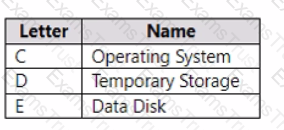
On VM1, you plan to install an app named App1. The data for App1 must be stored on a persistent data disk assigned to drive D.
You need assign the data disk to drive D.
What should you do on VM1 first?
Note: This question is part of a series of questions that present the same scenario. Each question in the series contains a unique solution that might meet the stated goals. Some question sets might have more than one correct solution, while others might not have a correct solution.
After you answer a question in this section, you will NOT be able to return to it. As a result, these questions will not appear in the review screen.
You have a server named Server1 that runs Windows Server 2022 and has the DHCP Server role. Server1 contains a single DHCP scope named Scope1.
You deploy five printers to the network.
You need to ensure that the printers are always assigned the same IP address.
Solution: You create a DHCP reservation for each printer.
Does this meet the requirement?
You have on-premises file servers that run Windows Server as shown in the following table.

You have the Azure file shares shown in the following table.
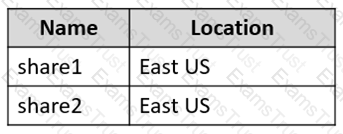
You add a Storage Sync Service named Sync1 and an Azure File Sync sync group named Group1. Group1 uses share1 as a cloud endpoint.
You register Server1 and Server2 with Sync1. You add D:\Folder1 from Server1 as a server endpoint in Group1.
For each of the following statements, select Yes if the statement is true. Otherwise, select No.
NOTE: Each correct selection is worth one point.

You need to sync files from an on premises server named Server1 to Azure by using Azure File Sync.
You have a cloud tiering policy that is configured for 30 percent free space and 70 days.
Volume E on Server1 is 500 GB.
A year ago, you configured E:\Data on Server1 to sync by using Azure File Sync. The files that are visible in E:\Data are shown in the following table.

Volume E does NOT contain any other files.
Where are File1 and File3 located? To answer, select the appropriate options in the answer area.
NOTE: Each correct selection is worth one point.
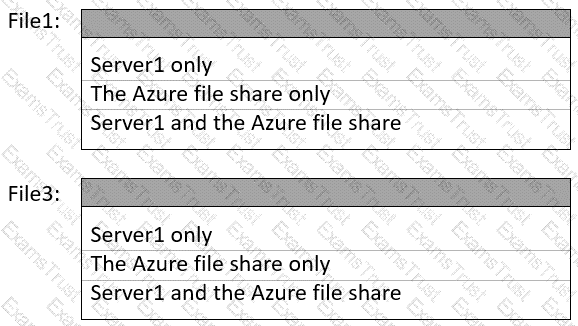
Your network contains an Active Directory Domain Services (AD DS) domain named adatum.com. The domain contains a server named Server1 and the users shown in the following table.
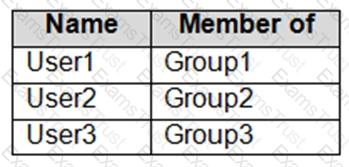
Server1 contains a folder named D:\Folder1. The advanced security settings for Folder1 are configured as shown in the Permissions exhibit. (Click the Permissions tab.)
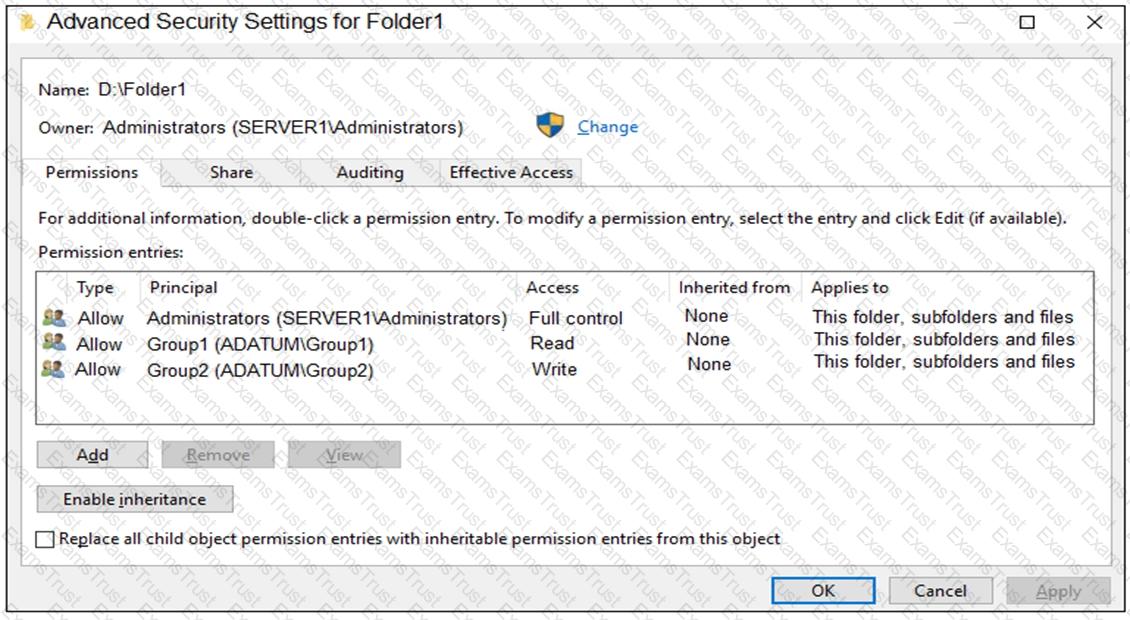
Folder1 is shared by using the following configurations:

The share permissions for Share1 are shown in the following table.

For each of the following statements, select Yes if the statement is true. Otherwise, select No.
NOTE: Each correct selection is worth one point.
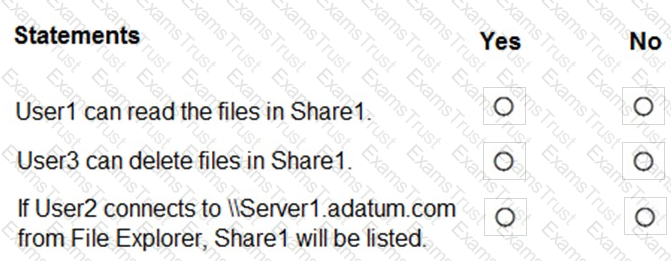
Your network contains the domains shown in the following exhibit.
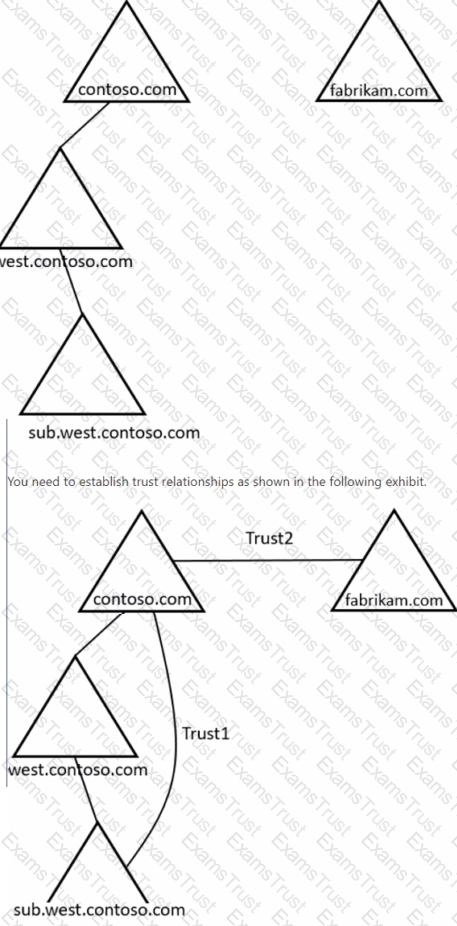
Which type of trust can you use for Trust1 and Trust2? To answer, select the appropriate options in the answer area.
NOTE: Each correct selection is worth one point.
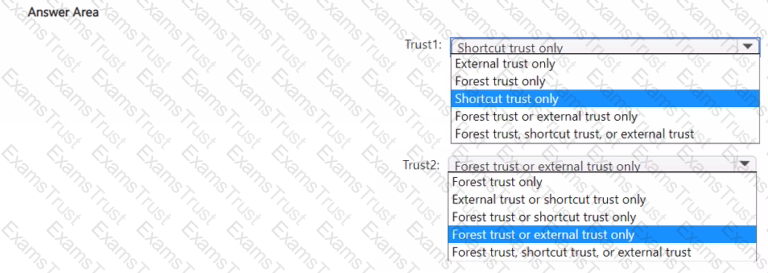
You have a disaggregated cluster deployment. The deployment contains a scale-out file server (SOFS) cluster that runs Windows Server and a compute duster that has the Hyper-V role enabled.
You need to implement Storage Quality of Service (QoS). The solution must ensure that you can control the bandwidth usage between the SOFS cluster and the Hyper-V cluster.
Which cmdlet should you run on each cluster? To answer, drag the appropriate cmdlets to the correct clusters. Each cmdlet may be used once, more than once, or not at all. You may need to drag the split bar between panes or scroll to view content.
NOTE: Each correct selection is worth one point.

You have an Active Directory Domain Services (AD DS) domain that contains the member servers shown in the following table.

Server3 contains a data disk named Disk1 that has Data Deduplication installed. Disk1 contains the files shown in the following table.
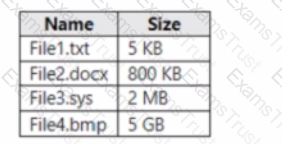
Server3 fails.
You need to recover the files on Disk1.
Which files can you recover if you attach Disk1 to Server 1, and which files can you recover if you attach Disk1 to Server2? To answer, select the appropriate options in the answer
area.
NOTE: Each correct selection is worth one point.
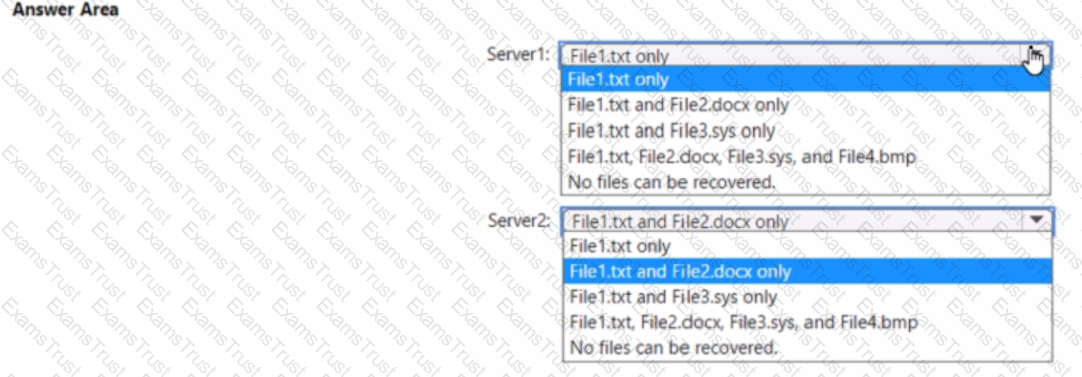
You have servers that have the DNS Server role installed. The servers are configured as shown in the following table.

All the client computers in the New York office use Server2 as the DNS server.
You need to configure name resolution in the New York office to meet the following requirements:
Ensure that the client computers in New York can resolve names from contoso.com.
Ensure that Server2 forwards all DNS queries for internet hosts to 131. 107.100.200.
The solution must NOT require modifications to Server1.
Each correct answer presents part of the solution.
NOTE: Each correct selection is worth one point.
You need to ensure that access to storage1 for the Marketing OU users meets the technical requirements.
What should you implement?
You need to implement the planned changes for Microsoft Entra users to sign in to Server1.
Which PowerShell cmdlet should you run?
You need to meet technical requirements for HyperV1.
Which command should you run? To answer, select the appropriate options in the answer area.
NOTE: Each correct selection is worth one point.

DC1 fails.
You need to meet the technical requirements for the schema master.
Yourunntdsutil.exe.
Which five commands should you run in sequence? To answer, move the appropriate commands from the list of commands to the answer area and arrange them in the correct order?

You need to ensure that Automanage meets the technical requirements.
On which Azure virtual machines should you enable Automanage?
You need to ensure that data availability on SSPace1 meets the technical requirements.
What is the maximum number of physical disks that can fail on each disk? To answer, select the appropriate options in the answer area.
NOTE: Each correct selection is worth one point.
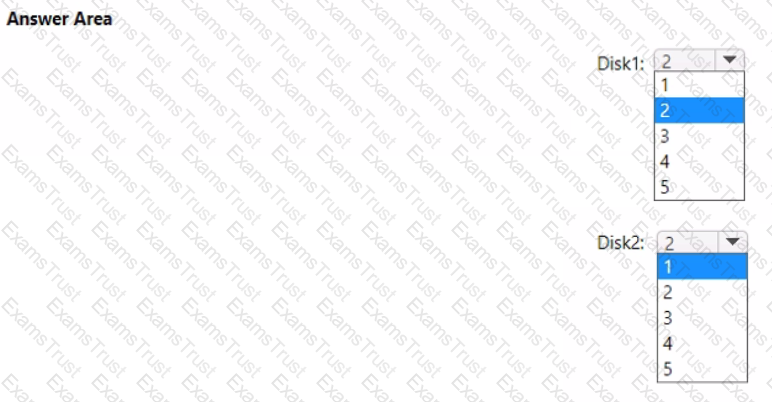
You need to implement the planned changes for the Azure DNS Private Resolver.
Which private DNS zones can you use for name resolution?
You need to ensure that VM3 meets the technical requirements.
What should you install first?
You need to implement the planned change for Data1.
Which actions should you perform in sequence? To answer, drag the appropriate actions to the correct order. Each action may be used once, more than once, or not at all. You may need to drag the split bar between panes or scroll to view content.
NOTE: Each correct selection is worth one point.

Which two languages can you use for Task1? Each correct answer presents a complete solution.
NOTE: Each correct selection is worth one point.
What should you implement for the deployment of DC3?
You need to implement a name resolution solution that meets the networking requirements. Which two actions should you perform? Each correct answer presents part of the solution.
NOTE: Each correct selection is worth one point
You need to configure Azure File Sync to meet the file sharing requirements. What should you do? To answer, select the appropriate options in the answer area. NOTE Each correct selection is worth one point.

Which three actions should you perform in sequence to meet the security requirements for Webapp1? To answer, move the appropriate actions from the list of actions to the answer area and arrange them in the correct order.
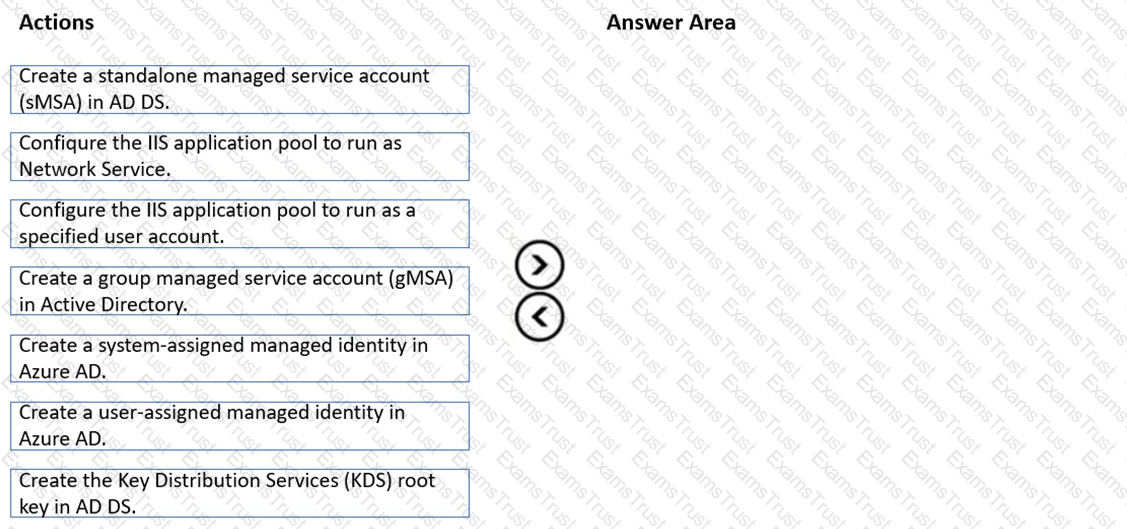
Task 3
You need to run a container that uses the mcr.microsoft.com/windows/servercore/iis image on SRV1. Pott 60 on the container must be published to port 5001 on SRV1 and the container must run in the background.
Task 2
You need to ensure that you can manage SRV1 remotely by using PowerShell
Task 10
You use a Group Policy preference to map \\dd.contoso.com\instal1 as drive H for all users. If a user already has an existing drive mapping for H. the new drive mapping must take precedence.
Task 6
You need to ensure that you can manage DC1 by using Windows Admin Center on SRV1.
The required source files are located in a folder named \\dc1.contoso.com\install.
Task 6
You need to use Azure File Sync 10 replicate the contents of C:\app on SRV1 to an Azure file share named sharel1.
The required source files are located in a folder named \\dc1.contoso.com\install.
Task 10
You need to configure Hyper-V to ensure that running virtual machines can be moved between SRV1 and SRV2 without downtime.
You do NOT need to move any virtual machines at this time.
Task 7
You need to monitor the security configuration of DC1 by using Microsoft Defender for Cloud.
The required source files are located in a folder named \\dc1.contoso.com\install.
Task 1
You need to create a group-managed service account (gMSA) named gMSA1 and make gMSA1 available on SRV1.
Task 7
You need to collect the recommended Windows Performance Counters from SRV1 in a Log Analytics workspace.
The required tiles are stored in a shared folder named \dc\install.
Task 5
You have an application that is copied to a folder named C:\app on SRV1. C:\app also contains also a Dockerfile for the app.
On SRV1. you need to create a container image for the application by using the Dockerfile. The container image mutt be named app1.
Task 5
You need to ensure that a DHCP scope named scope! on SRV1 can service client requests.
Task 4
You need to register SRV1 to sync Azure file shares The registration must use the 34646045 Storage Sync Service.
The required source files are located in a folder named \\dc1.contoso.com\install.
You do NOT need to configure file share synchronization at this time and you do NOT need to update the agent.
Task 8
You need to deploy a new primary DNS zone named fabrikam.com to DC1. The zone must be signed.
Task 9
You plan to create group managed service accounts (gMSAs).
You need to configure the domain to support the creation of gMSAs.
You need to meet the technical requirements for User1. The solution must use the principle of least privilege.
What should you do?
You need to meet the technical requirements for Server1. Which users can currently perform the required tasks?
You need to meet the technical requirements for VM2.
What should you do?
You need to meet the technical requirements for VM3
On which volumes can you enable Data Deduplication?
Which groups can you add lo Group3 and Groups? To answer, select the appropriate options in the answer area. NOTE Each correct selection is worth one point.

You need to meet the technical requirements for VM1.
Which cmdlet should you run first? To answer, select the appropriate options in the answer area.
NOTE: Each correct selection is worth one point.

For each of the following statements, select Yes if the statement is true. Otherwise, select No.
NOTE: Each correct selection is worth one point.

You need to meet the technical requirements for Server4.
Which cmdlets should you run on Server1 and Server4? To answer, select the appropriate options in the answer area.
NOTE: Each correct selection is worth one point.
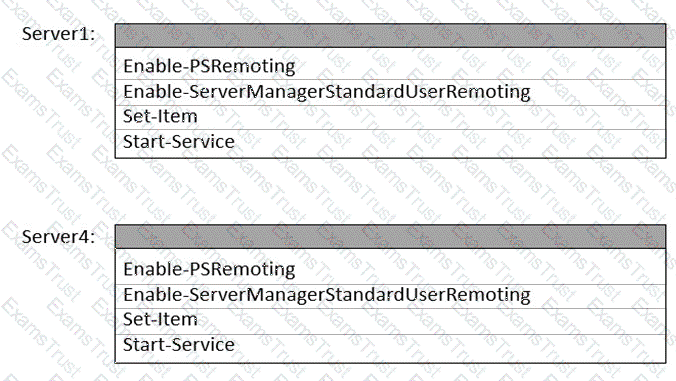
Which groups can you add to Group3 and Group5? To answer, select the appropriate options in the answer area.
NOTE: Each correct selection is worth one point.
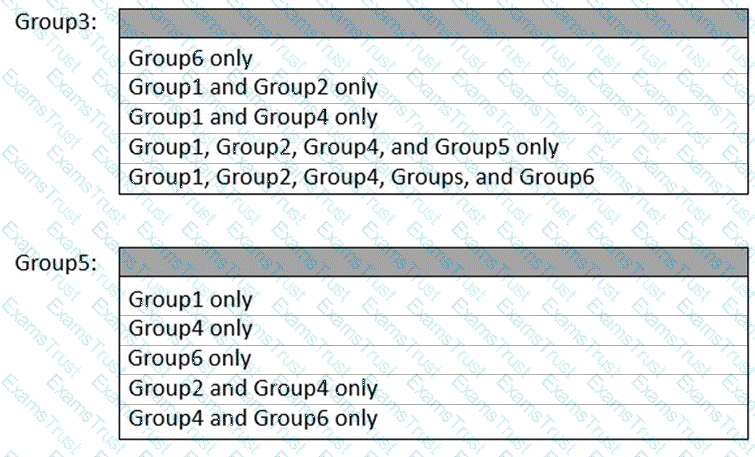
You need to meet the technical requirements for the site links. Which users can perform the required tasks?